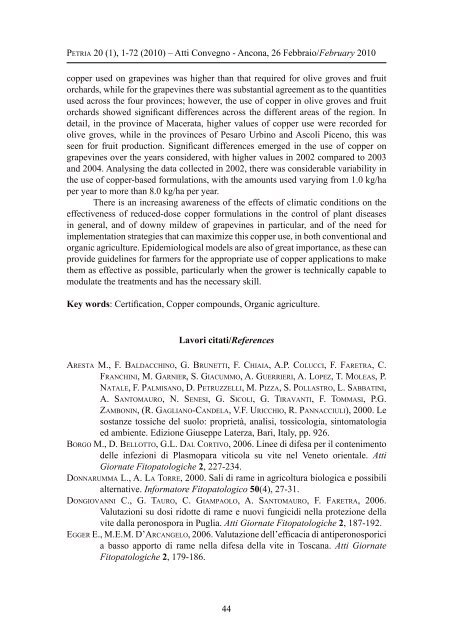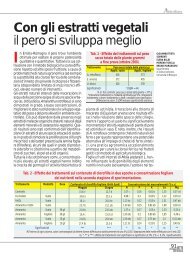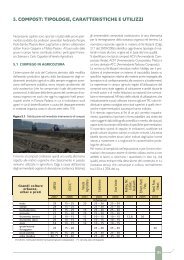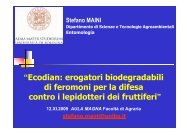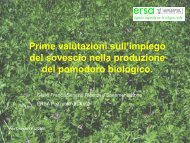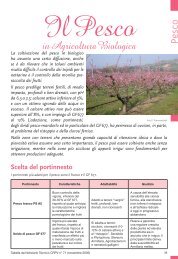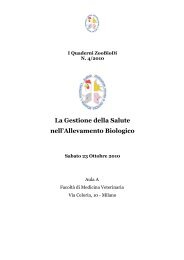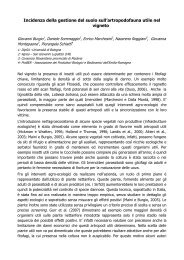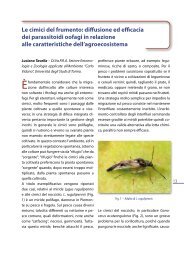You also want an ePaper? Increase the reach of your titles
YUMPU automatically turns print PDFs into web optimized ePapers that Google loves.
Petria 20 (1), 1-72 (2010) – Atti Convegno - Ancona, 26 Febbraio/February 2010copper used on grapevines was higher than that required for olive groves and fruitorchards, while for the grapevines there was substantial agreement as to the quantitiesused across the four provinces; however, the use of copper in olive groves and fruitorchards showed significant differences across the different areas of the region. Indetail, in the province of Macerata, higher values of copper use were recorded forolive groves, while in the provinces of Pesaro Urbino and Ascoli Piceno, this wasseen for fruit production. Significant differences emerged in the use of copper ongrapevines over the years considered, with higher values in 2002 compared to 2003and 2004. Analysing the data collected in 2002, there was considerable variability inthe use of copper-based formulations, with the amounts used varying from 1.0 kg/haper year to more than 8.0 kg/ha per year.There is an increasing awareness of the effects of climatic conditions on theeffectiveness of reduced-dose copper formulations in the control of plant diseasesin general, and of downy mildew of grapevines in particular, and of the need forimplementation strategies that can maximize this copper use, in both conventional andorganic agriculture. Epidemiological models are also of great importance, as these canprovide guidelines for farmers for the appropriate use of copper applications to makethem as effective as possible, particularly when the grower is technically capable tomodulate the treatments and has the necessary skill.Key words: Certification, Copper compounds, Organic agriculture.Lavori citati/ReferencesAresta M., F. Baldacchino, G. Brunetti, F. Chiaia, A.P. Colucci, F. Faretra, C.Franchini, M. Garnier, S. Giacummo, A. Guerrieri, A. Lopez, T. Moleas, P.Natale, F. Palmisano, D. Petruzzelli, M. Pizza, S. Pollastro, L. Sabbatini,A. Santomauro, N. Senesi, G. Sicoli, G. Tiravanti, F. Tommasi, P.G.Zambonin, (R. Gagliano-Candela, V.F. Uricchio, R. Pannacciuli), 2000. Lesostanze tossiche del suolo: proprietà, analisi, tossicologia, sintomatologiaed ambiente. Edizione Giuseppe Laterza, Bari, Italy, pp. 926.Borgo M., D. Bellotto, G.L. Dal Cortivo, 2006. Linee di difesa per il contenimentodelle infezioni di Plasmopara viticola su vite nel Veneto orientale. AttiGiornate Fitopatologiche 2, 227-234.Donnarumma L., A. La Torre, 2000. Sali di rame in agricoltura biologica e possibilialternative. Informatore Fitopatologico 50(4), 27-31.Dongiovanni C., G. Tauro, C. Giampaolo, A. Santomauro, F. Faretra, 2006.Valutazioni su dosi ridotte di rame e nuovi fungicidi nella protezione dellavite dalla peronospora in Puglia. Atti Giornate Fitopatologiche 2, 187-192.Egger E., M.E.M. D’Arcangelo, 2006. Valutazione dell’efficacia di antiperonosporicia basso apporto di rame nella difesa della vite in Toscana. Atti GiornateFitopatologiche 2, 179-186.44


